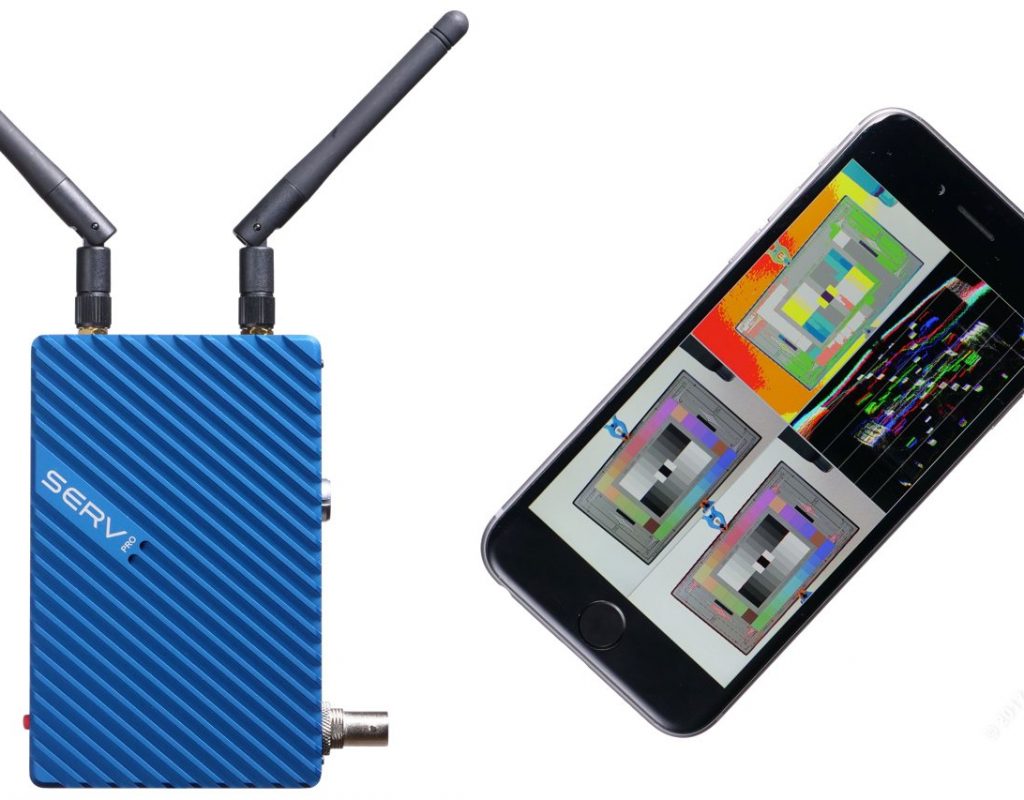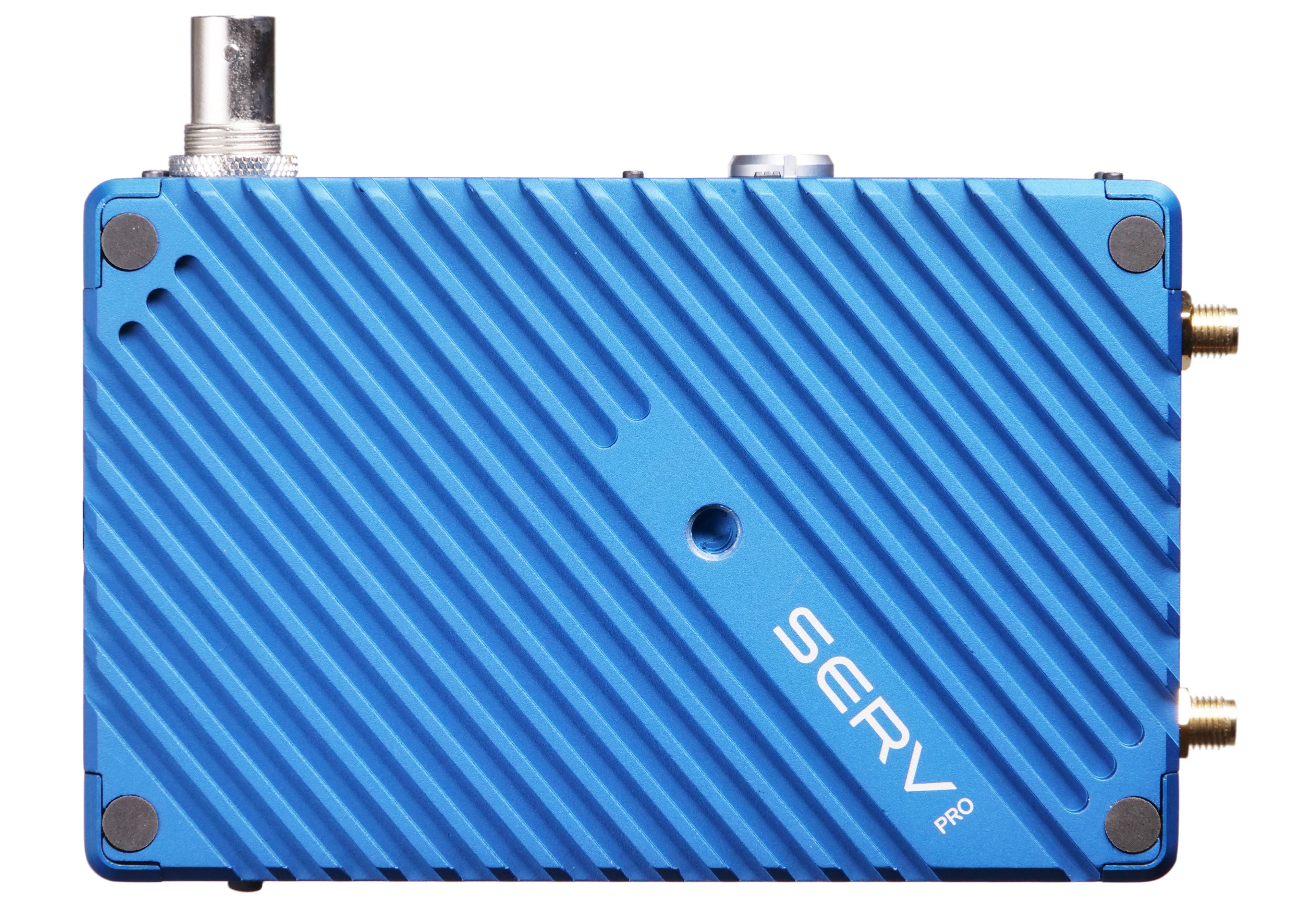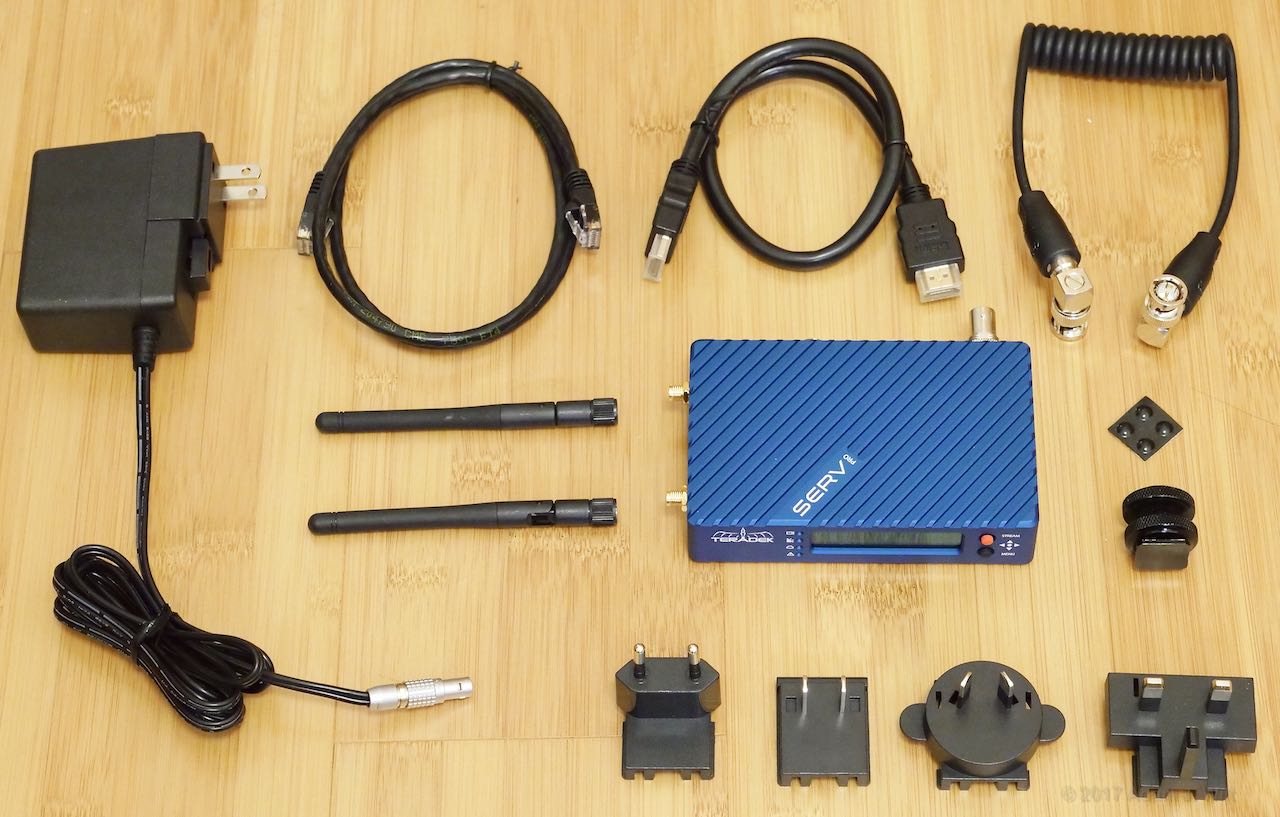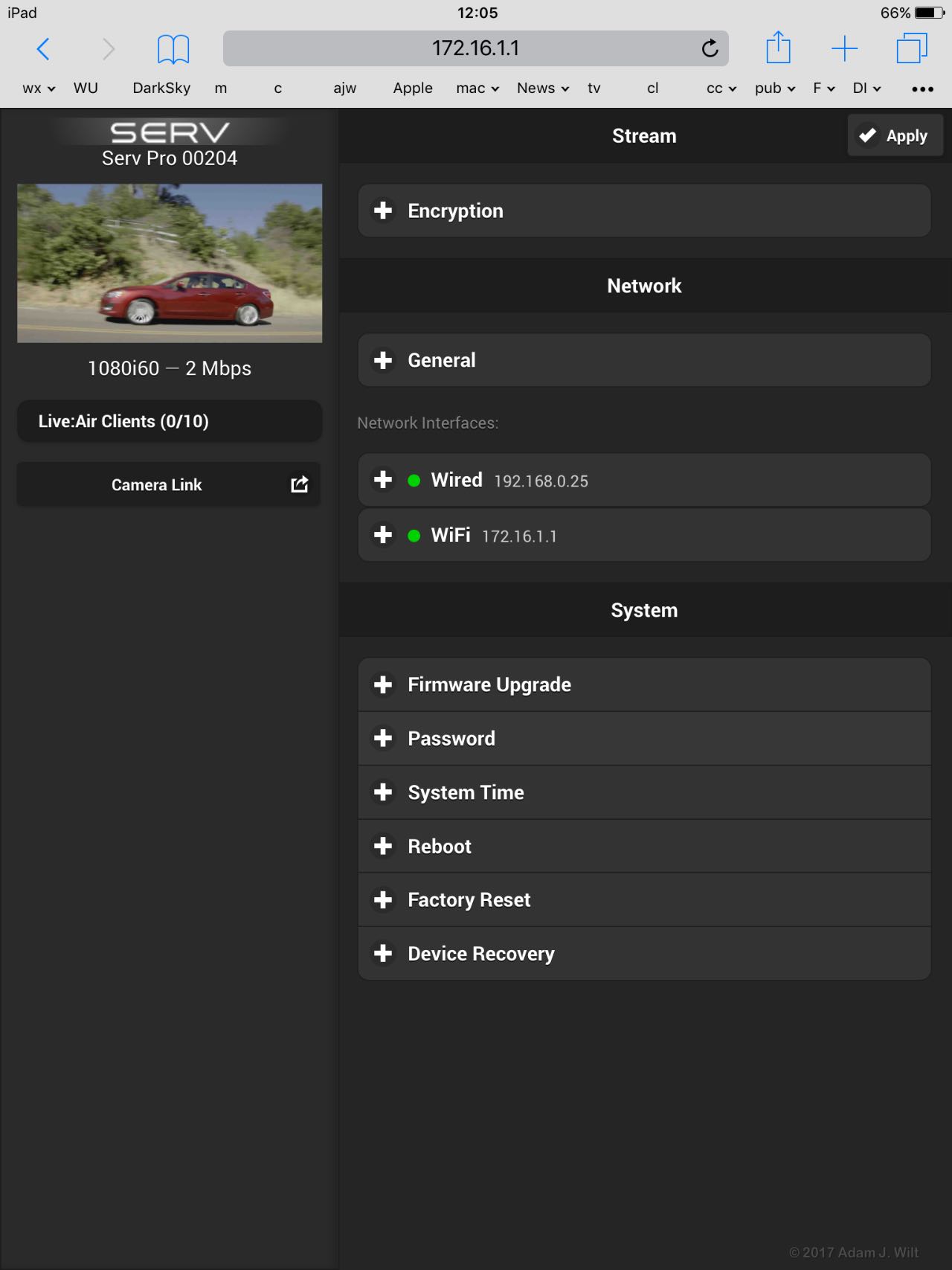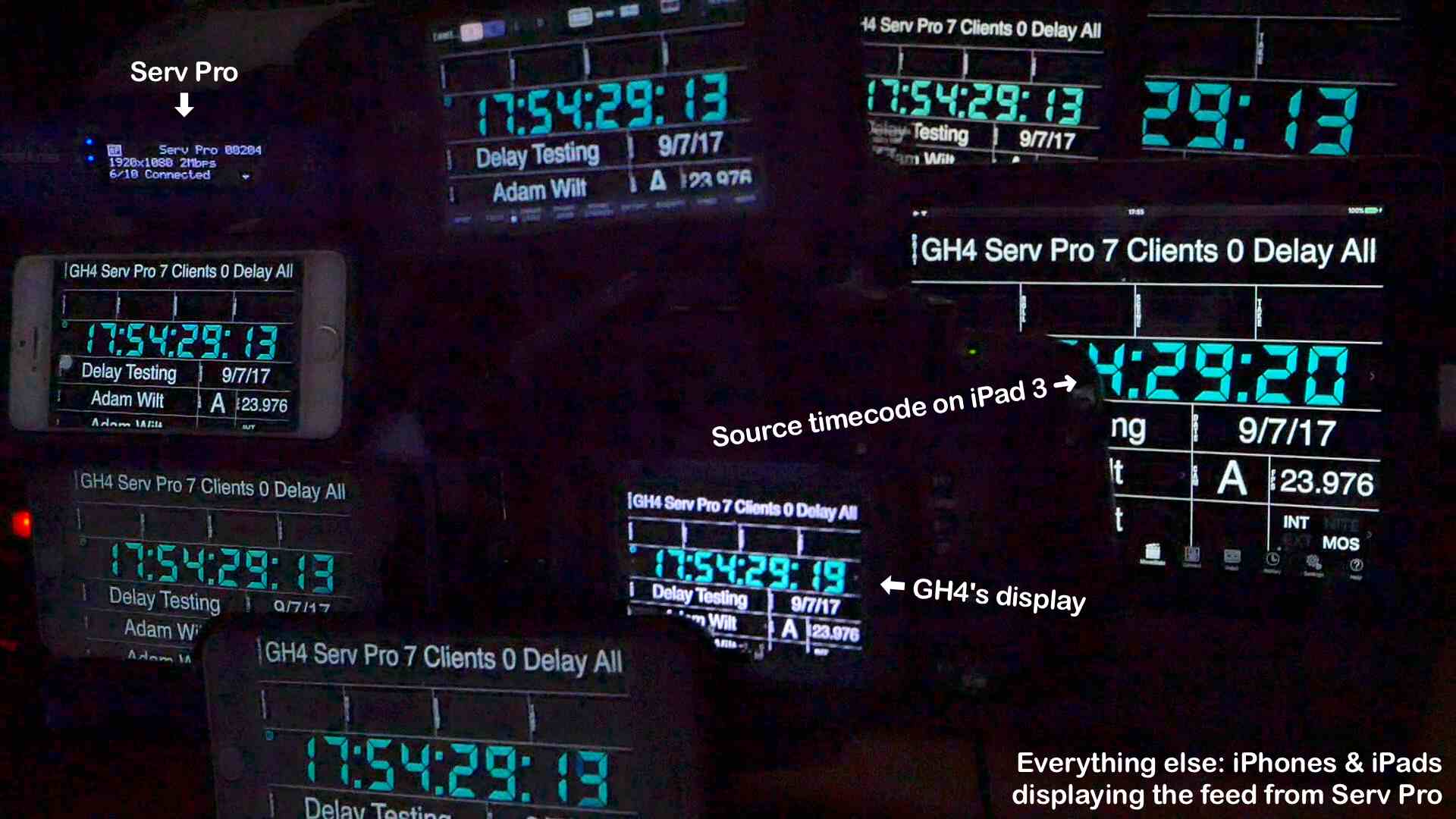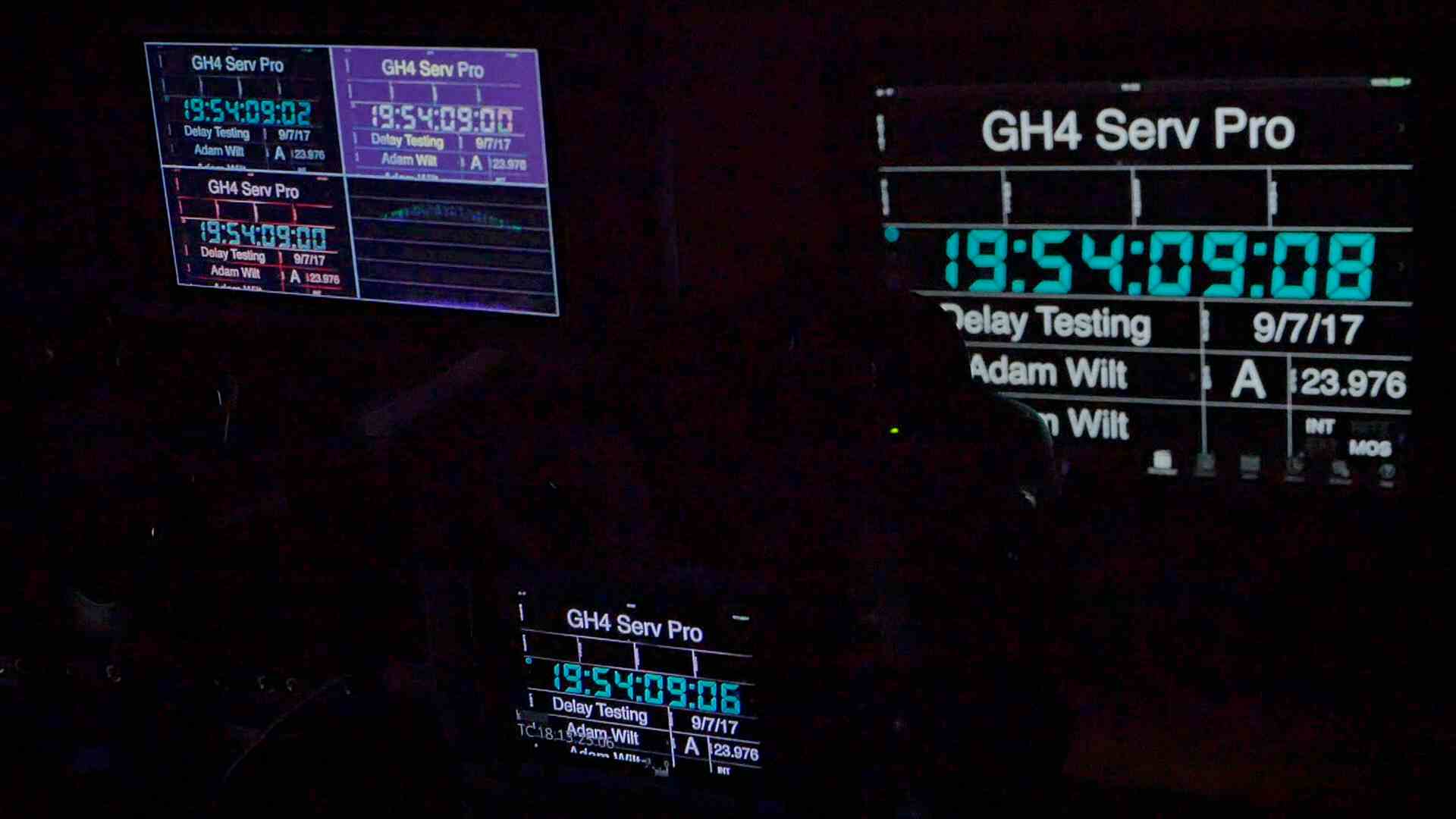Teradek’s Serv Pro is a $1799 camera-top wireless transmitter, sending H.264 video and audio to as many as ten iPhones, iPads, or iPod touches. VUER is the free app that receives the Serv Pro’s transmissions. The two combined form a wireless monitoring system for any production that needs to show a feed to multiple people and doesn’t want the bother of running cables.
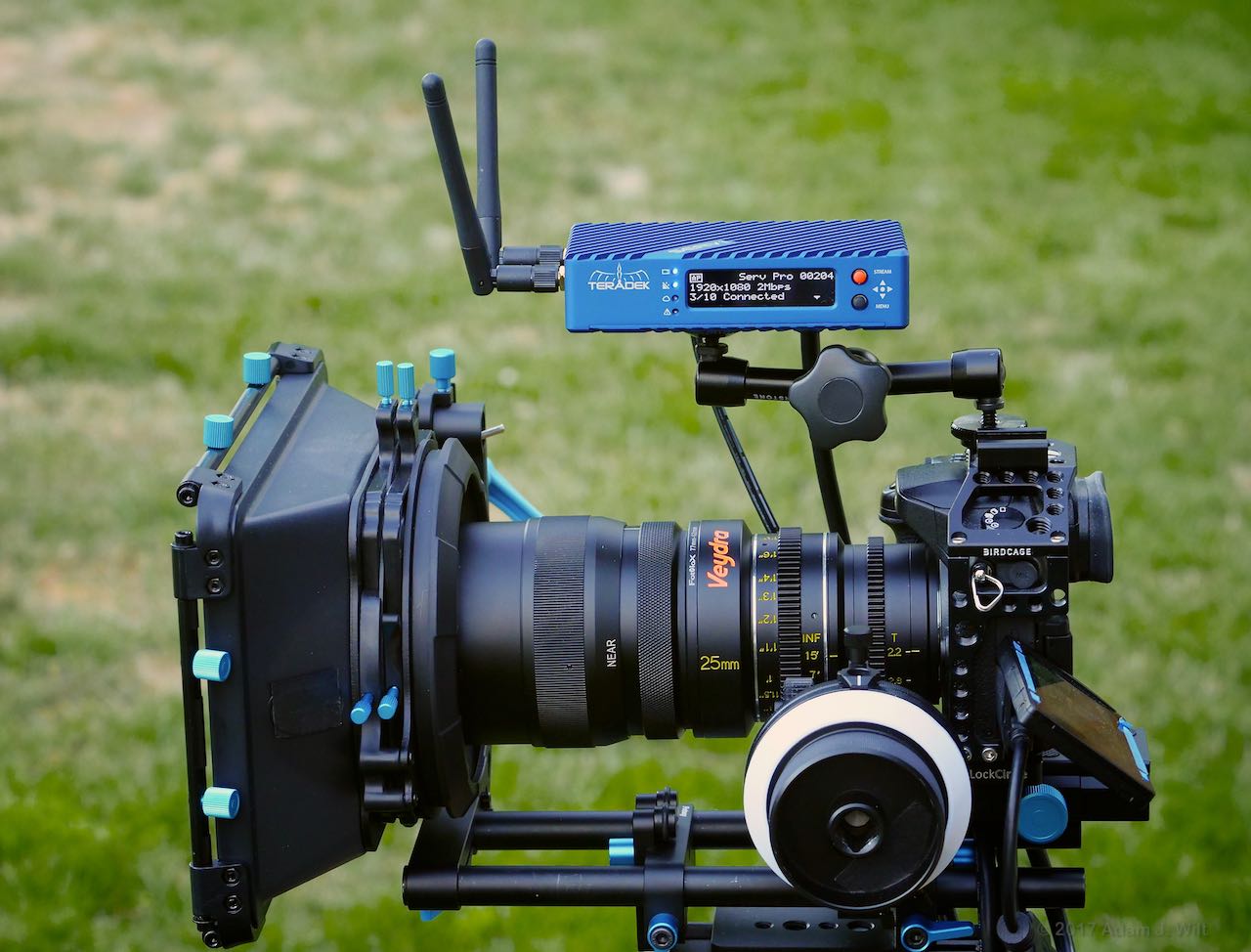
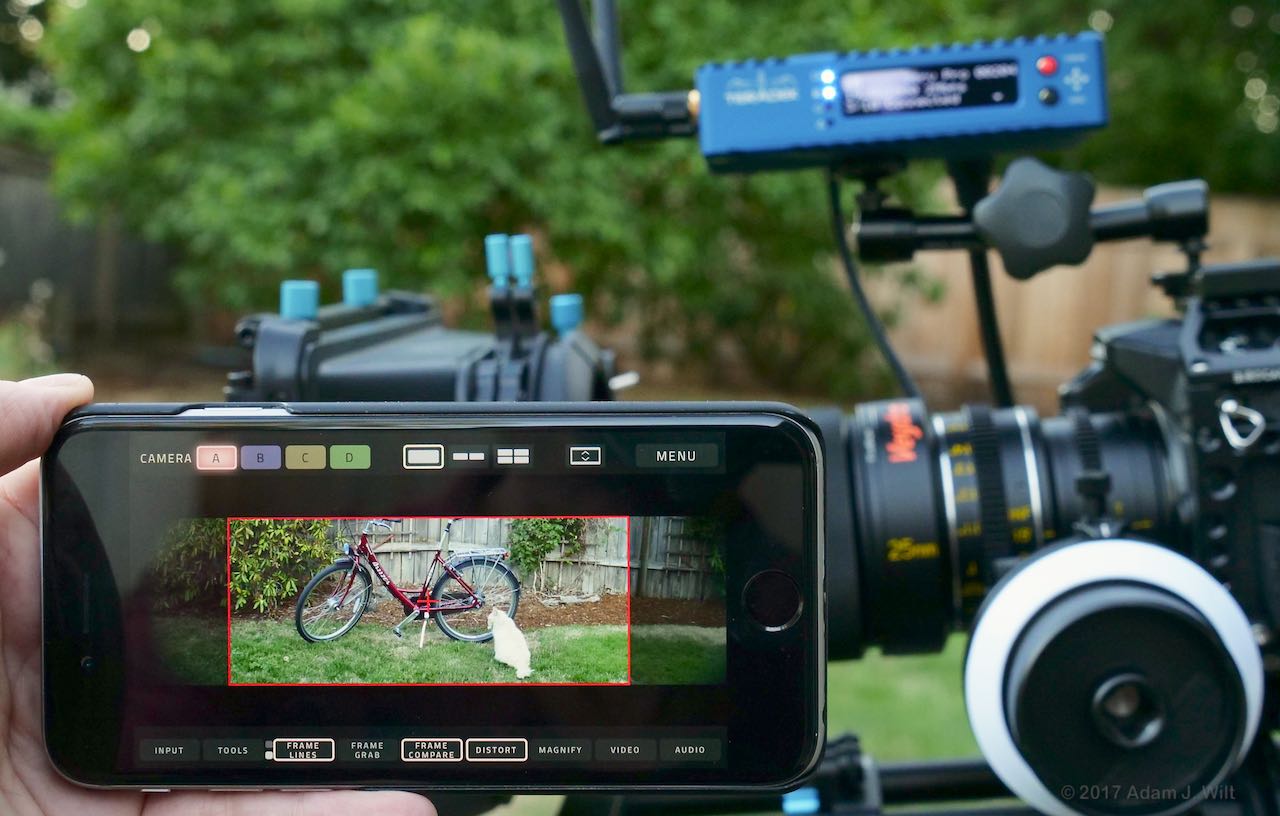
Serv Pro fills a unique niche. There are uncompressed camera-top transmitters like the Paralinx systems and Teradek’s own Bolt series; these are real-time links with zero latency—or close enough as makes no difference—sending signals from cameras to one or more receivers, which then feed SDI or HDMI to monitors. These systems use dedicated high-bandwidth radio links and require matched transmitter/receiver pairs. Uncompressed transmitters are the industry standard for wireless monitoring, as the signal is detailed enough and timely enough for remote operating, focus-pulling, and engineering.
There are compressed systems, like Teradek’s Cube and VidiU, which send long-GOP video over Wi-Fi, Wired Ethernet, and/or 3G+ mobile channels. These systems are designed to be used for live streaming, but can also send pictures and sound to apps on mobile devices like iPads and iPhones, which act as combined receivers and displays.
As iPhones and iPads have become commonplace, Cubes and their ilk have been pressed into service as non-realtime “secondary” transmitters for those who can live with the slight delay incurred by long-GOP H.264 compression. It’s not uncommon on larger productions for a Bolt or Paralinx system to send a feed to video village, where a Cube transmitter re-encodes the feed for distribution to Various Important People with iDevices. Cubes also work as primary wireless transmitters on lower-budget (or just lower-footprint) productions, offering comparatively low-cost remote monitoring for cameras on gimbals, Steadicams, shoulder rigs, jibs, and car mounts.
It’s a handy thing to be able to do, but as iPhones and iPads proliferate on-set, Cubes show their limits: they’re fine feeding two or three iOS devices, but have increasing difficulty with more, lagging intolerably when trying to handle more than four. They can also be daunting to set up due to their more complex configuration menus—a necessity given their wide-ranging capabilities.
Thus the Serv Pro: a dedicated iOS streamer. Teradek says a Serv Pro will feed ten iOS devices as easily as one. That’s all it does. It’s very much a one-trick pony, but if that’s the sort of trick you need to pull off, this is the pony to do it.
Serv Pro Hardware
The Serv Pro is wrapped in a blue anodized aluminum box, 4.75″ x 3″ x 1.1″ (121 x 76 x 28mm), with diagonally-grooved heat dissipation fins. With its two Wi-Fi antennas attached it tips the scales at 14 oz (398g).
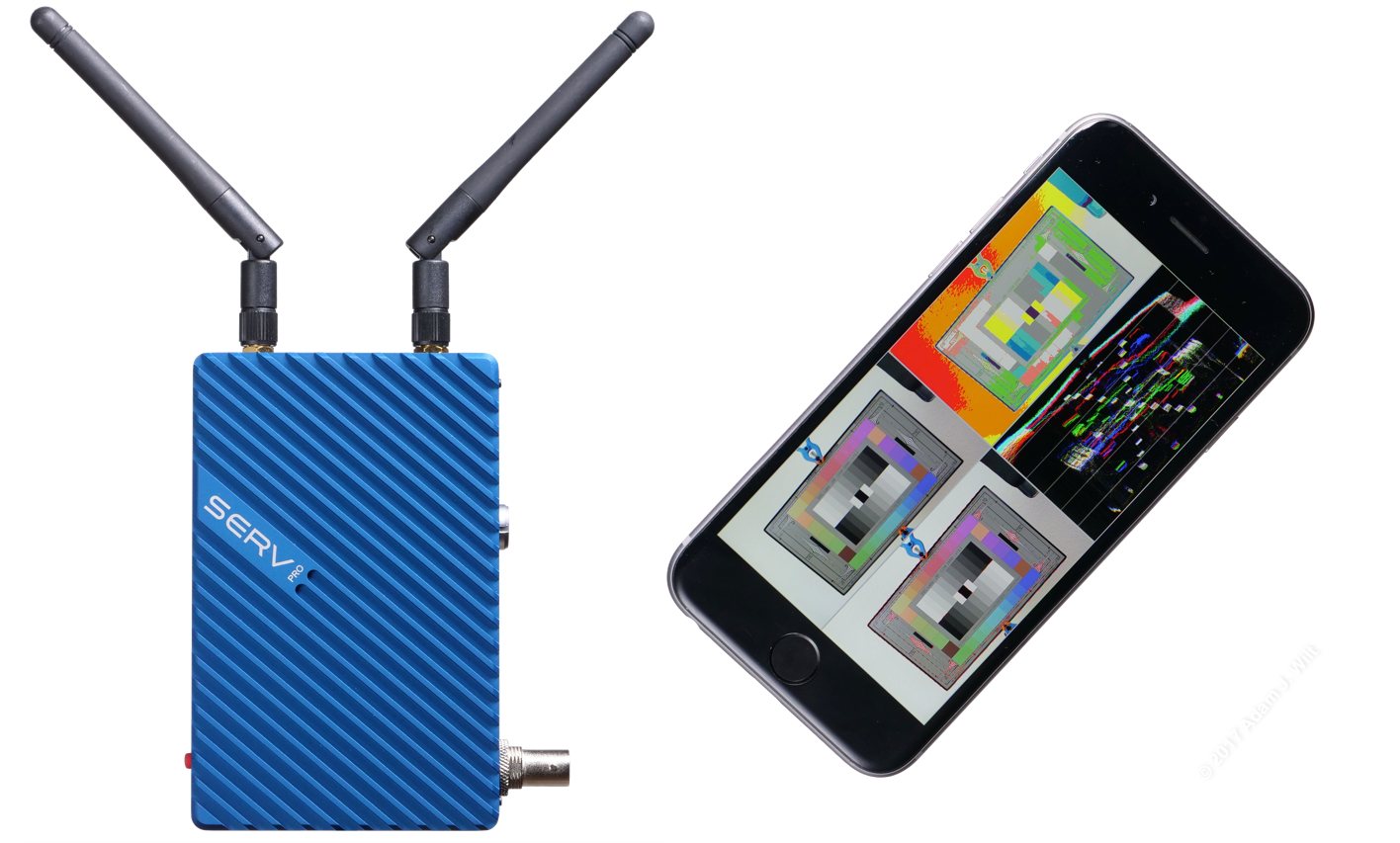
The left side (assuming you mount the device with the control panel on the left) has four status LEDs and a dot-matrix display, plus two stubby rubber joystick-buttons for menu navigation.
There’s a 1/4×20 mounting socket on the back.
The right side has an HD-SDI input BNC, a full-size HDMI input, a 10/100/1000baseT wired Ethernet port, a two-pin Lemo power input with a power switch, and a 3.5mm minijack for line/mic audio input (SDI and HDMI allow embedded audio, too).
The front has two terminals for the supplied Wi-Fi antennas.
The underside has another 1/4×20 mounting point.
The Serv Pro comes with two tiltable antennas; a multivoltage AC adapter, including plugs for just about anywhere in the world; a 1/4×20 shoe mount adapter; short Ethernet and HDMI cables; a very slick coiled SDI cable with right-angle BNCs; and four adorably tiny rubber stick-on feet in case you wish to use Serv Pro flat on a table.
There’s also a single sheet of instructions. Because that’s all you need.
Operation
Mount the Serv Pro where it’s needed. Connect your input. Supply power. Turn it on. You’re done. Seriously, you can be up and running that easily. Serv Pro comes out of the box set up to establish its own wireless network (Access Point mode, in Teradek terms) and start streaming as soon as it’s initialized.





From power on to pictures received in VUER takes just over two minutes. Unlike 2nd-generation Cubes, Serv Pro does not have an internal bridge battery, so you’ll be off-air for two minutes at every power change. The DC input on the Serv Pro accepts 6–28 volts and both Teradek and third parties offer a variety of power input cables and battery plates; a D-tap cable is perhaps the most common cable used.
Serv Pro dissipates about 8 watts, and the casing gets quite warm in use, though not uncomfortably so. If you’re going to put it flat on a table, use those rubber feet, so air can circulate beneath the box.
By default, the Serv Pro auto-selects a channel on either 2.4GHz or 5GHz Wi-Fi bands and creates an open network. Anyone with VUER loaded on an iOS device can connect to that network and start viewing the feed.
If you prefer, you can limit channel selection to either the 2.4 or 5GHz bands, choose the channel directly, enable Wi-Fi password protection and/or stream encryption (encryption requires the just-released version 2.1 firmware), and/or switch the Serv Pro into “infrastructure mode” to connect through a different Wi-Fi network instead of creating its own. All this can be done using the side panel’s display and joysticks, or—more easily—through the embedded webpage, available over both the wired and wireless interfaces.
Why would an iOS streaming device offer a wired interface? It’s handy for firmware updates, and for Camera Link: Serv Pro can act as a wireless access point for a variety of cameras with Ethernet ports, so you can connect to their embedded webservers from your iPhone or iPad.
VUER
VUER is Teradek’s free app for receiving Serv Pro feeds. It runs on any iDevice with an A7 or better processor (iPhone 5S or later, iPad 5th generation or later, iPad mini 2 or later, iPod touch 6G) running iOS 9 or later. It can display one, two, or four images simultaneously from up to four Serv Pros and/or 3rd-generation Cubes, depending on the iDevice—it only allowed three simultaneous feeds on my iPad Air.
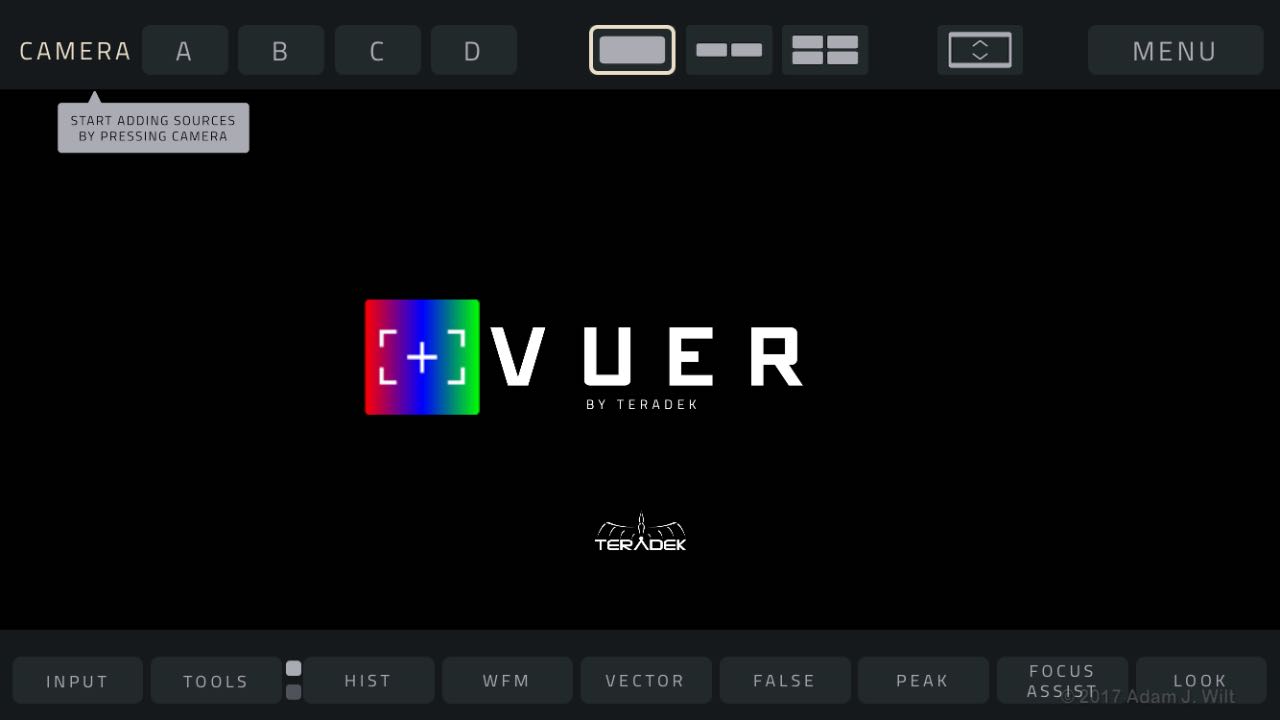
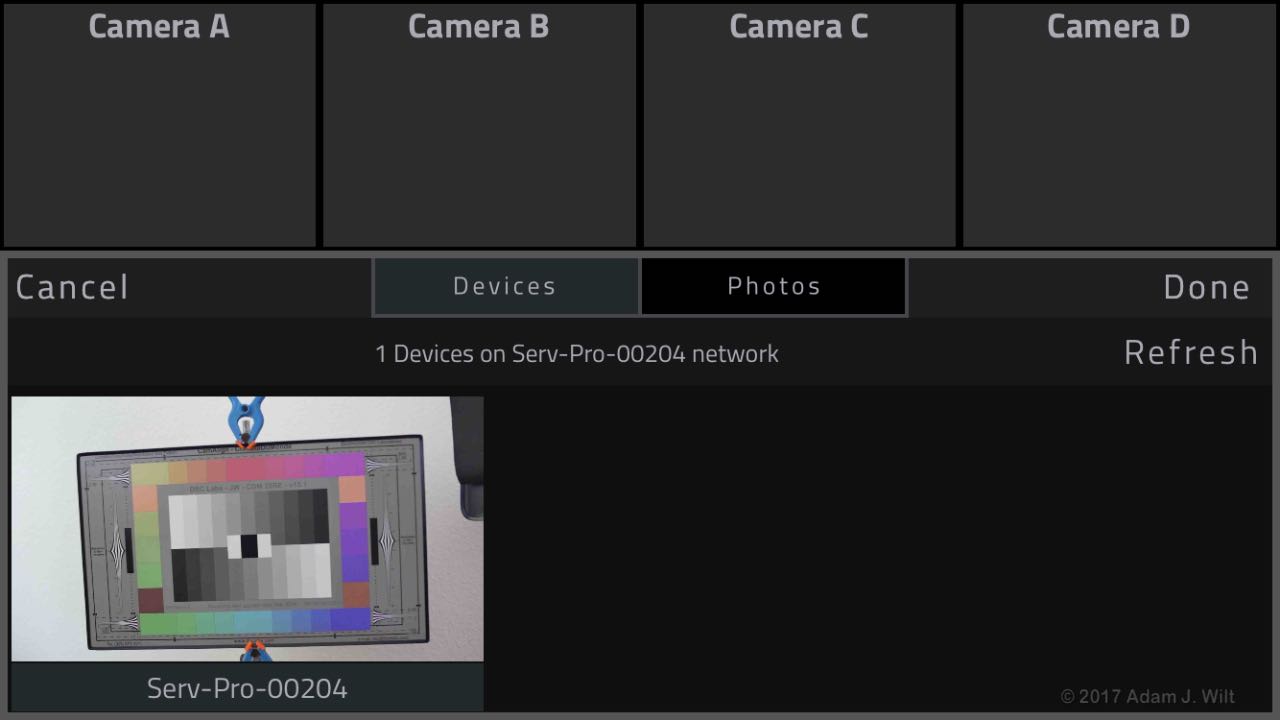
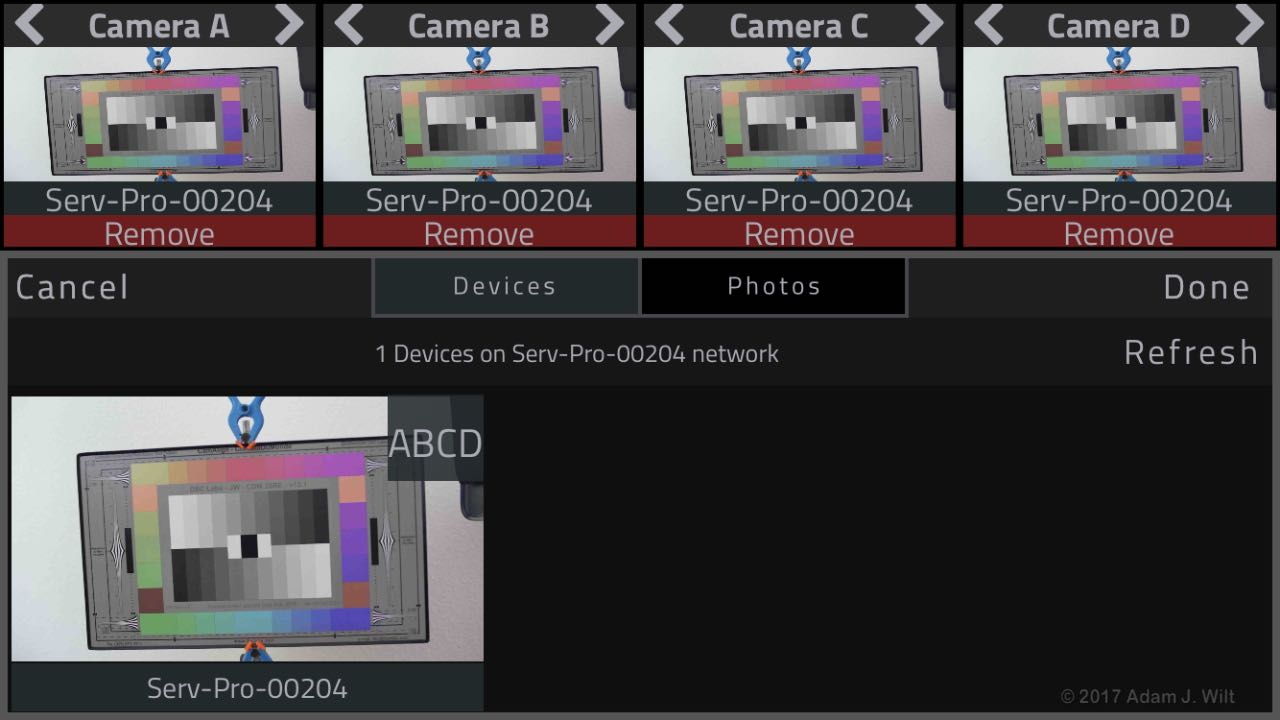
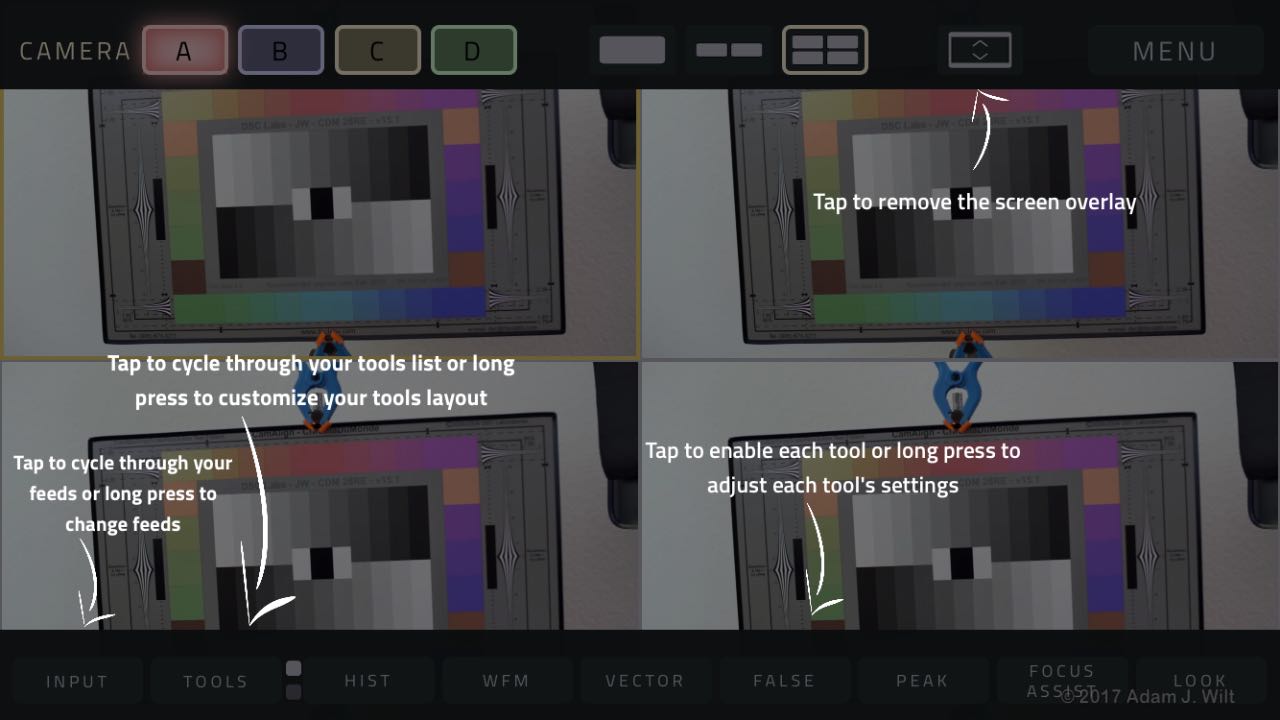
VUER offers a wide variety of settings and adjustments. You can pinch-zoom the image. You can apply peaking (“analog style”, in white), focus assist (“digital style” in several colors), false color, anamorphic desqueeze, and ‘scopes: waveform monitor, vectorscope, and histogram. You can also load LUTs or CDLs, and display a CDL editor onscreen:
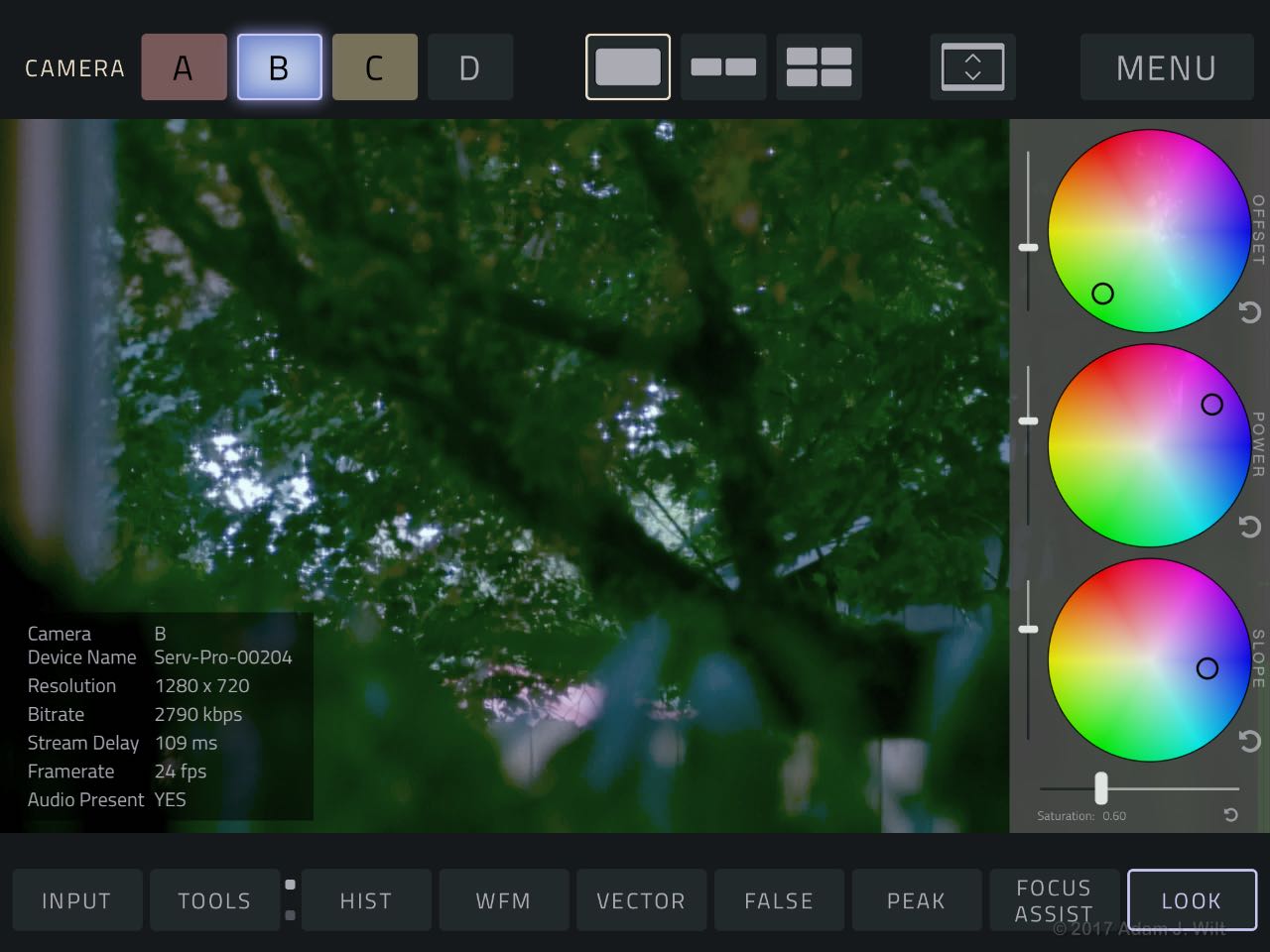
There’s even a link to Pomfort LiveGrade: VUER can control LiveGrade, or vice versa.
You have control over the Serv Pro’s resolution and bitrate, and VUER’s decoding delay. Lowering resolution and/or bitrate may allow better performance on congested networks or at longer distances. Adding some delay—up to 1 second—may help when signal quality is poor; there’s time for retries when packets get dropped. Teradek’s TeraView app helpfully labels its version of this slider as “Lower Delay” vs. “Smoother Video”.
VUER gives you direct control over the iDevice’s screen brightness and audio volume, so you don’t have to fumble with buttons or the iOS control panel. Combinations of inputs and screen layouts can be saved as workspaces, so you can bounce between different setups without manually reconfiguring your inputs and displays. There’s a frame grab manager, so you can save grabbed frames to the Camera Roll or load them from the Camera Roll; frame grabs can be supered and crossfaded to/from using a Frame Compare tool.
Teradek has a hands-on walkthrough video, and here are a few screenshots:
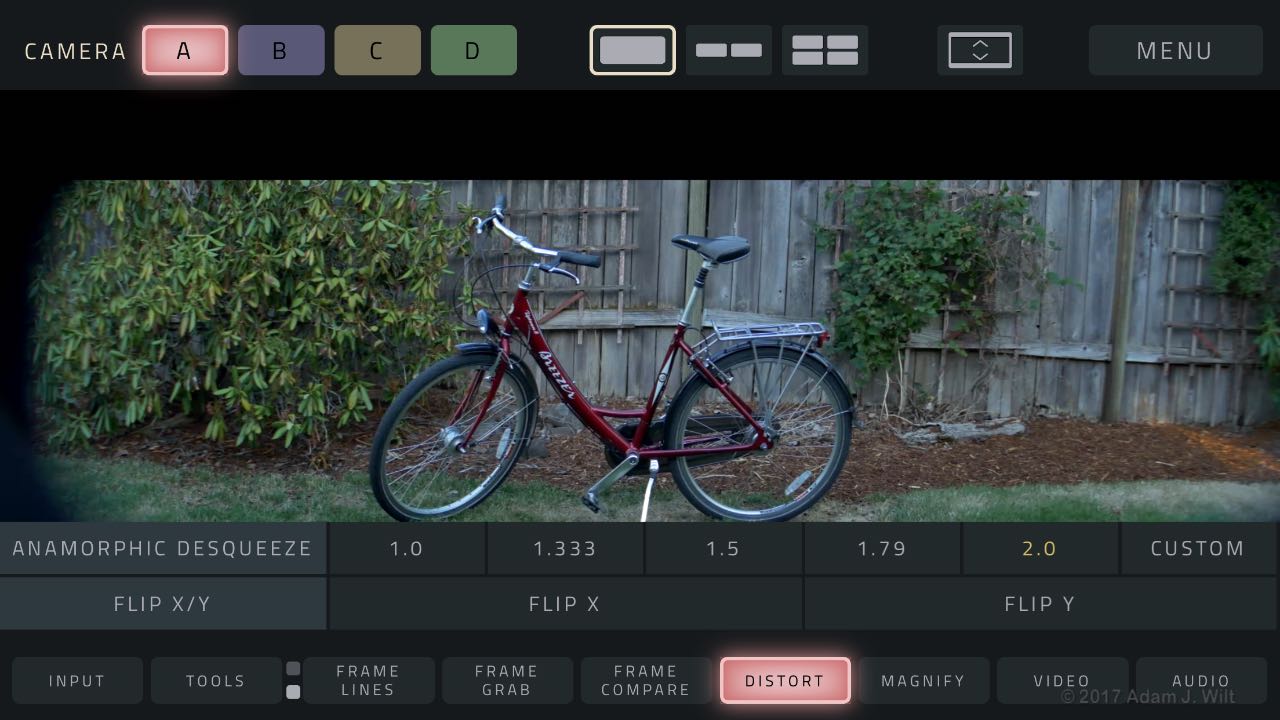
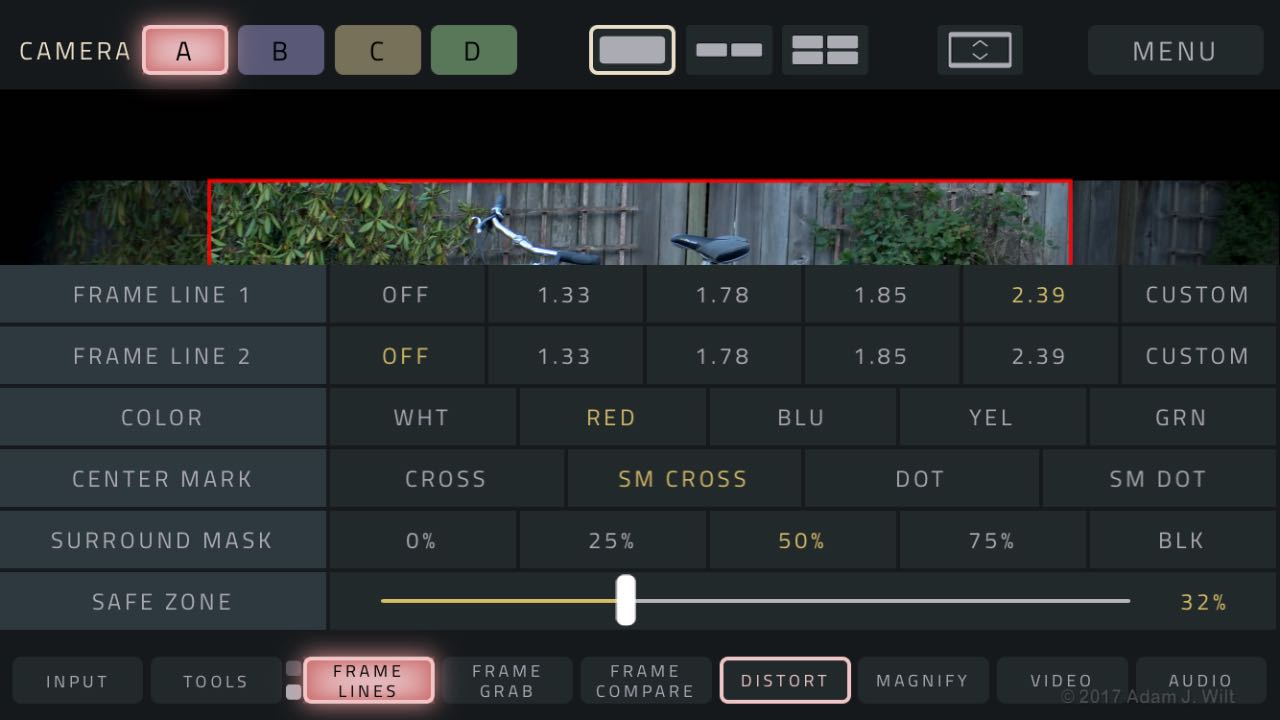
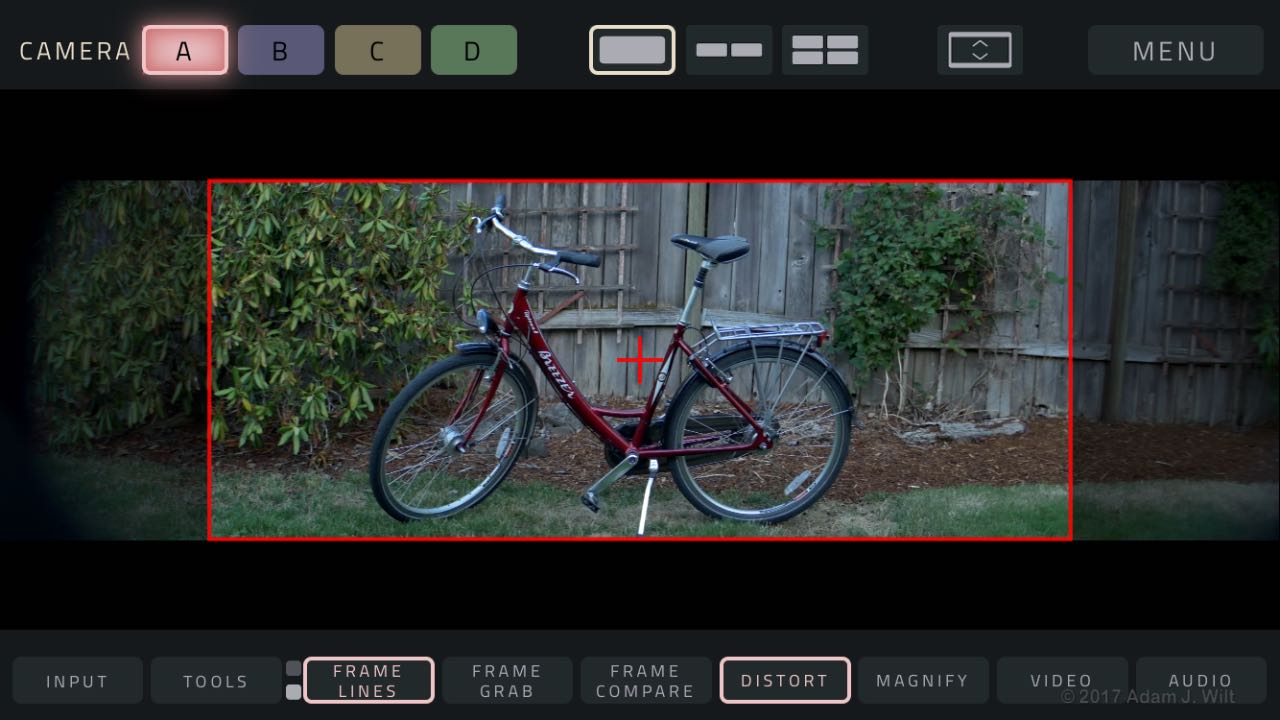
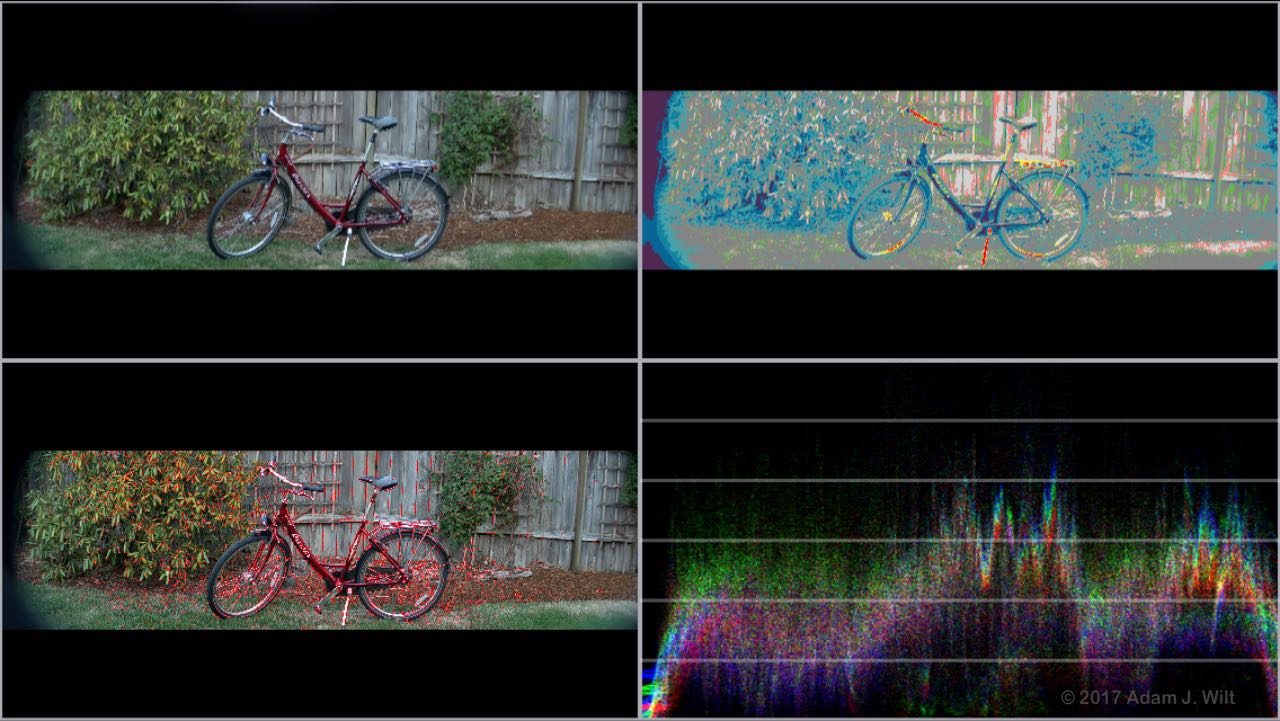
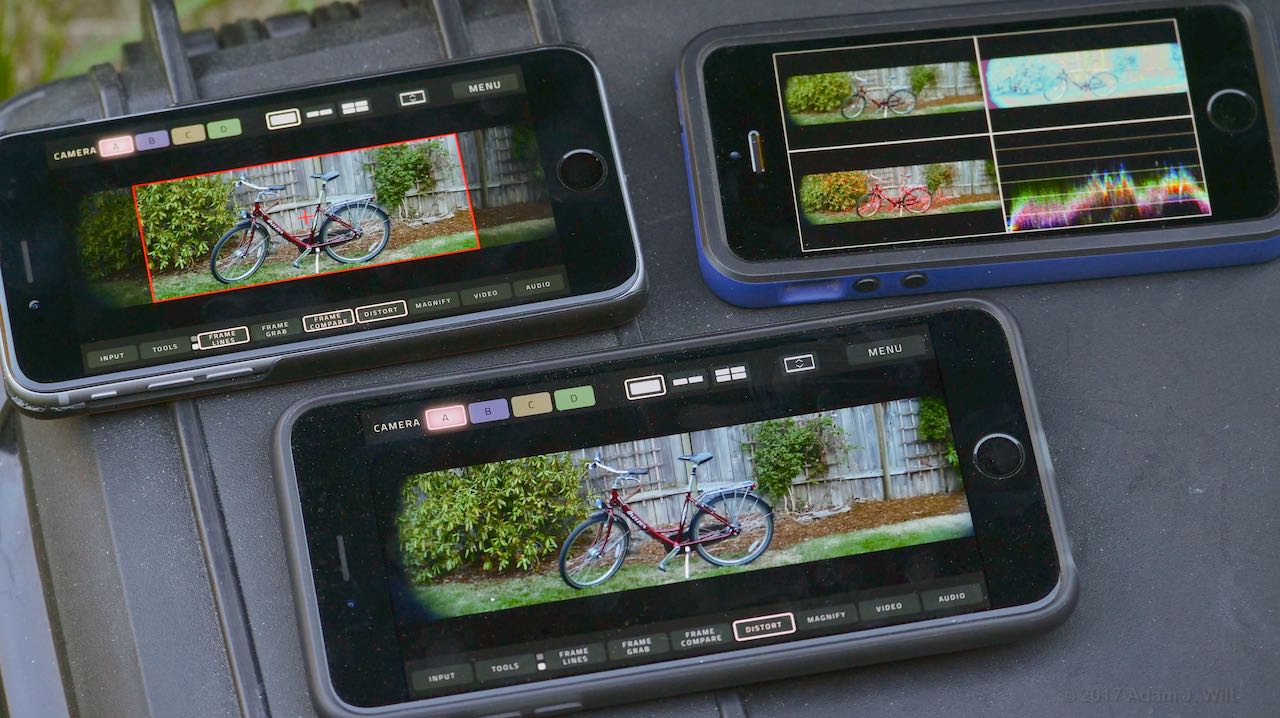
Performance
Teradek claims that Serv Pro supports up to ten iOS clients with a mere two-frame delay at distances of up to 300 feet. I set out to test this as best I could.
To look at delay, I compared Serv Pro (connected to an iPhone SE) against a Video Devices PIX-E5 and a Convergent Design Odyssey 7Q+, all fed from the same HDMI output on a GH4. I set up a “shoot ‘em all” scene as described here, capturing the live image off MovieSlate’s timecode display alongside the output of the device under test. I shot a few seconds of each scene, and looked at the lag in the readout of the device being tested as compared to the source timecode slate. I did the tests with the slate and the taking camera set to 60p, and then at 24p (60p is a bit of a cheat, as the Serv Pro’s transmitted image tops out at 1080/30p, but at least I’d get a high-temporal-resolution result). Note that VUER defaults to a 200ms delay; I set its delay to 0ms to get the lowest possible latency.
At 60p, the image displayed by the Serv Pro was usually 5 60p frames behind those of the Pix-E and Odyssey. I say “usually” because once in a while the delay was a frame better or a frame worse; H.264 over Wi-Fi doesn’t have a guaranteed latency. 60p is 2.5x faster than 24p; 5 ÷ 2.5 = 2 frames of delay at 24p.
And sure enough, at 24p, the Serv Pro was usually 2 frames behind the PIX-E or Odyssey. Those hardwired devices lagged the live image by 5 frames (the GH4’s HDMI delivery has its own not insubstantial delay), while the Teradek’s overall delay was usually 7 frames.
Furthermore, this same latency held with six clients:
The slate says “7 clients” because I expected an iPhone 4S to be in the mix, but it fell beneath VUER’s minimum requirements and I forgot to change the slate.
I had everything from an iPhone 5S to a pair of iPad Pros, and performance was comparable across all of them.
Adding an image effect like False Color or Focus Assist occasionally caused an additional frame or two of delay:
This only occurred perhaps a third of the time (I cherry-picked that frame grab), and it’s to be expected: adding a processing step adds a delay even if it’s usually under a frame.
Overall I’d rate this as excellent performance for a compressed transmitter using an iPhone as a a receiver/monitor. On a camera with a lower-latency output (yes, I know, like a real camera such as the F55, where the SDI output is only two frames behind reality), it may even be fast enough for operating or focus pulling in certain circumstances.
Mind you, this behavior was measured under near-ideal conditions: all receivers within arm’s length of the transmitter, in a reasonably uncrowded Wi-Fi environment.
Once I started walking away with my iPhones, I saw a gradual degradation in performance—both in overall latency, and in the smooth and continuous delivery of frames—depending on distance and the amount of stuff between transmitter and receiver. Putting as many interior walls between me and the Serv Pro as possible, I’d get hiccups and even the occasional total signal loss in under 50 feet (15 meters). With the rig outdoors, I was able to walk about 360 feet (110 meters) down the road before signal was lost, though I started seeing increased latency, hiccups, and dropped frames starting around 250 feet or so. At the 360 foot point, a delivery delay of over 4 seconds (as handily reported by VUER’s video statistics overlay) wasn’t unusual… but consider that I was 20% beyond the Serv Pro’s specified range.
It’s Wi-Fi, after all: it’s an unlicensed, shared chunk of spectrum, and performance is not guaranteed. If the built-in access point in the Serv Pro doesn’t have the punch you need, consider an industrial-strength access point with high-gain antennas, advanced beam-forming, and sophisticated interference rejection. Teradek makes their own, the production-friendly Link. Commercial units by the likes of Ubiquiti and Ruckus are how the pros provide access in trying situations; Teradek uses Ruckus APs at NAB and IBC (or at least they did before they built the Link), two shows with notoriously crowded Wi-Fi airwaves.
I can personally attest to the fact that at Teradek’s NAB booth, all the Cube and Serv Pro Wi-Fi feeds were smooth and problem-free. 100 feet away in the DSC Labs booth, I was trying to run a Cube in both standalone and infrastructure mode, using a weedy little consumer-grade access point. Half the time I couldn’t even connect an iPad to the Cube, and when I could, frame drops and scrambled video were common. The access point makes all the difference.
As far as VUER goes, it’s a very complete monitoring system. I found it useful to set up a quad-split, typically with a raw image, an image with focus assist, one with false color, and the fourth with a full-size, RGB overlay WFM. Double-tapping any quadrant makes that image full-screen; double-tap again to return to the quad split. Fast and easy.
I only have a couple of quibbles:
- The WFM and Histogram only show studio-swing range (0%–100%), so anything below black or between 100% and 109% will be lost. The WFM’s scale has divisions every 16.7%, unlike any other WFM around; the histogram is divided every 8.3%, likewise (in this way VUER is much like FCPX: the designers gave us scales because scales were on the feature list, without ever bothering to figure out what the scales should actually be. Not that I have an opinion or anything, mind you).
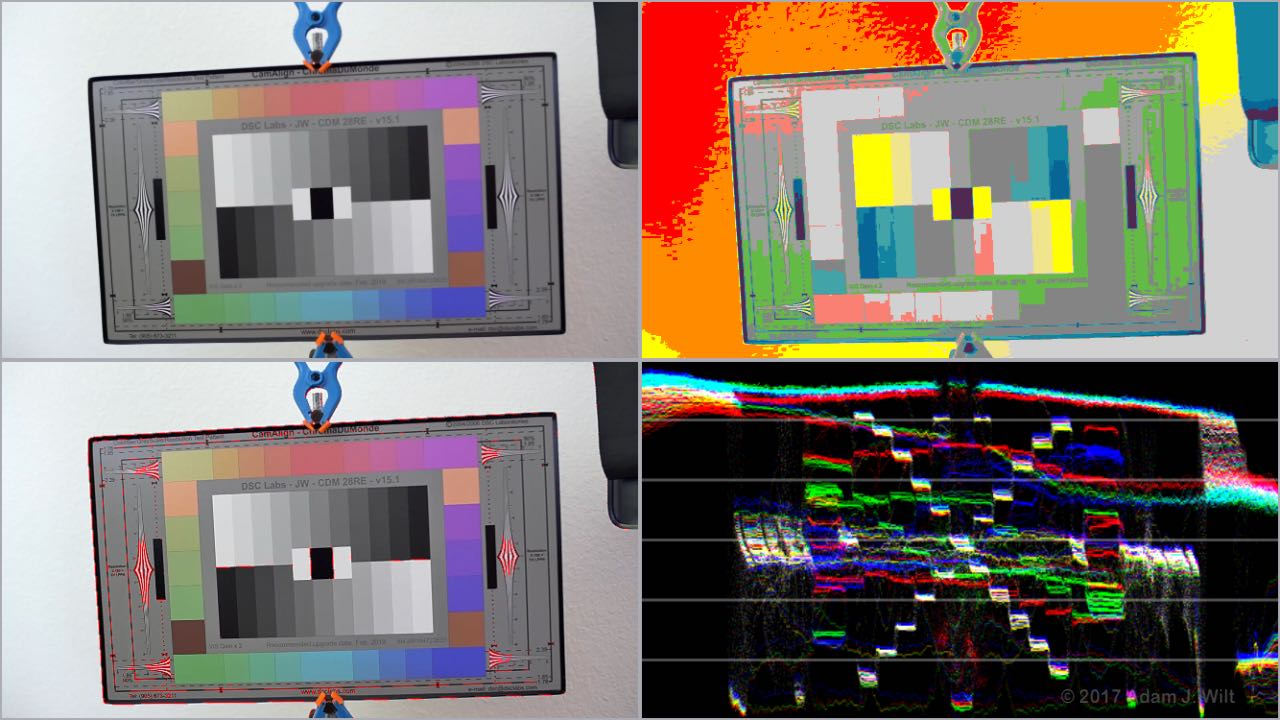
WFM: six steps from 0% to 100%? - The top-and-bottom control bars are outside the 16×9 picture area on a 1.5:1 iPad, but they overlay and obscure picture (and info boxes, and ‘scopes) on a 16×9 iPhone. Yes, the control bars are easily hidden, but as their background is opaque, it’s not always clear at a glance that they’re hiding anything beneath them.
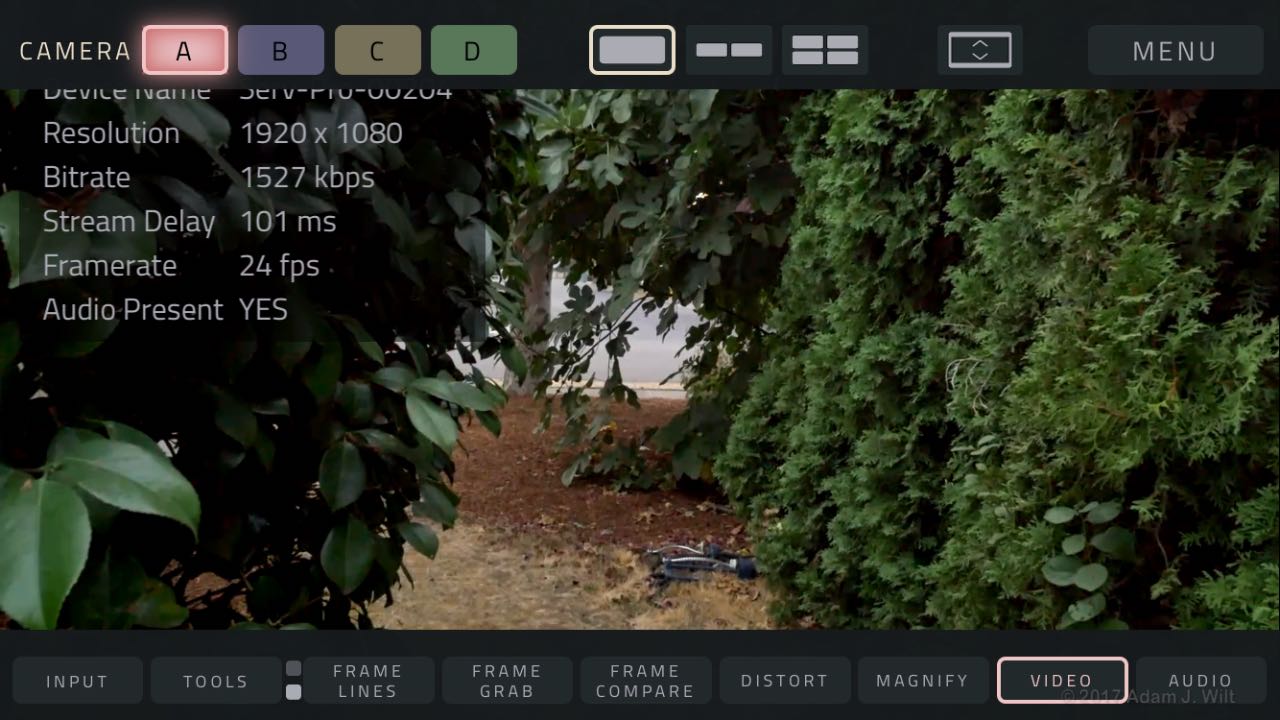
The menu bar overlays the data panel… 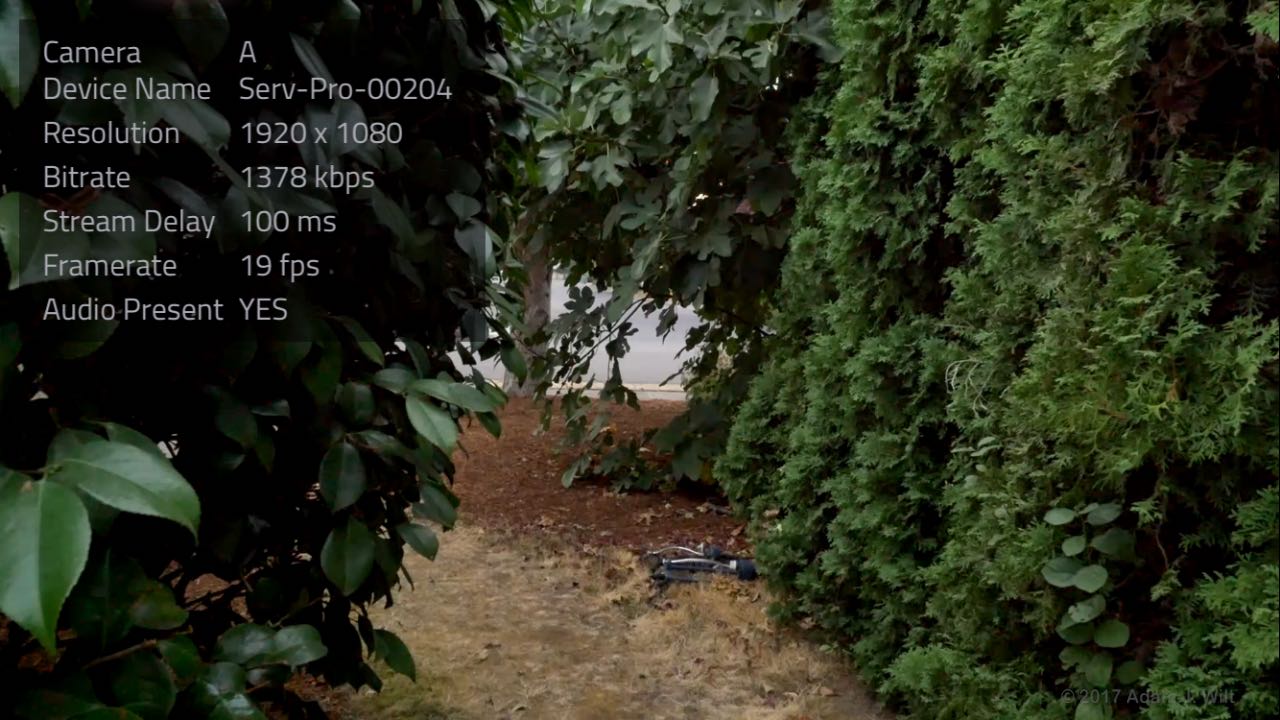
…and the picture too, as it turns out.
That’s all I can find to complain about, sorry. Teradek have done a fine job on the software.
VUER, like any such app, tends to be relatively power hungry: it’s flogging the hardware mercilessly to receive, decompress, process, and display images as quickly as possible. In my testing I typically saw a drop in battery level of 10% in half an hour whether I was using an iPhone or iPad: a fully charged iDevice will be drained in around five hours.
Conclusion
At $1799, Serv Pro isn’t cheap, but it’s pretty much the only game in town if you need to feed a multitude of iOS devices from a single transmitter.
Yes, a 2nd-generation Cube can be had for slightly less money (or rather less on the used market), but those cubes are HDMI-only or SDI-only, require considerably more configuration, won’t handle more than four clients, and don’t (officially or reliably) display in VUER. A Cube 655 costs $200 more and tops out at six clients, and it’s still a Swiss-Army-knife transmitter, with a plethora of possibly confusing configuration options.
At NAB 2017, Teradek also mentioned a Serv (not Pro), with HDMI only, a four-client limit, and a price around $700. That’ll be a good alternative if and when it ships (Teradek tells me it’s still on the roadmap, awaiting a new encoding platform), as long as you don’t need SDI and don’t need more than four clients. And, of course, it won’t help you today.
Here’s the beauty of the Serv Pro:
- Plug it in.
- Turn it on.
- Two minutes later: pictures!
It’’s hard to beat that.
If $1799 is a bit too spendy, consider renting one when you need it. They’re new, so not yet widely available, but a quick snuffling ‘round shows that Chater Camera in Berkeley CA has one for $150/day. Your local rental house might offer it, too, especially if you let ‘em know you need such a thing.
If you’ve come this far and are shaking your head at the things fools waste their money on, then Serv Pro isn’t for you. But if you need to feed pix and sound to Various Important People who can’t be tied down with wired monitors, you may very well look at it and say, “where’ve you been all my life?”
It’s a one-trick pony, but it does that trick very well indeed. It just works. Isn’t that what you want on a shoot?
Pros
- Drop-dead simple to use on default settings; easy enough to change those defaults when necessary.
- 1080p feeds to as many as 10 iOS devices with minimal delay.
- SDI and HDMI inputs, with embedded or separate audio.
- Full-featured VUER app with full look management, frame guides, engineering ‘scopes, false color, peaking, multiple feeds, multiple views, and more.
Cons
- $1799, not cheap! But if you need it, you need it.
- Two minutes from power on to picture, and no internal bridge battery.
Cautions
- Signal stability and latency are entirely at the mercy of local Wi-Fi conditions. If you need more range or robustness than Serv Pro’s default setup provides, it’s up to you to change the default settings, find uncongested channels, and/or configure an enterprise-class Wi-Fi access point to create your own Information Superhighway.
- Serv Pro serves video to iOS devices only. Android is not supported and there are no plans to do so in the future.
- VUER will drain an iDevice dry in about five hours, so tell your Director and AD and the other Important People to turn their devices off between setups, and not to just put ‘em down on a chair and wander away, leaving ‘em playing, or they won’t have any pretty pictures to look at after lunch. I know, it won’t work: people are forgetful and easily distracted, and it’ll be your fault their iPhones have run down and their iPads have died. No matter what happens, it’s always your fault. But that’s why you get paid the big, big money, right?
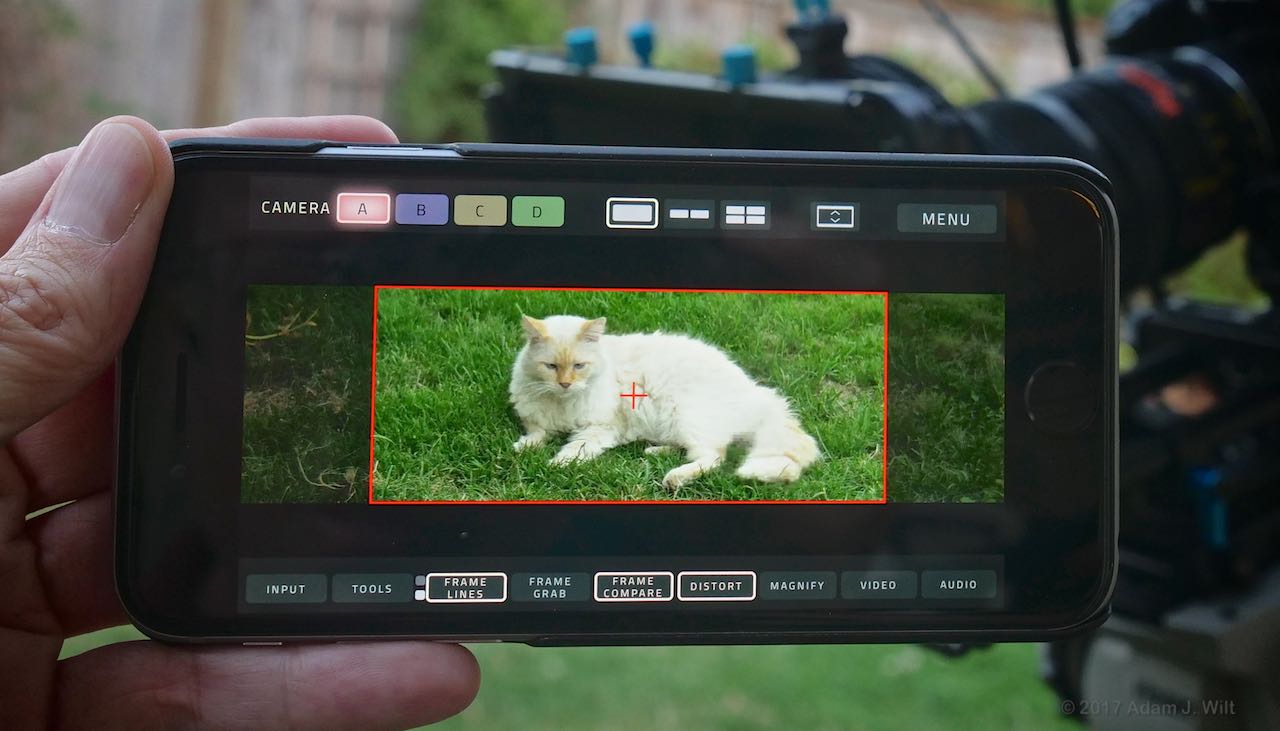
Disclosure: Teradek sent me a Serv Pro for review, and paid shipping both ways. I own two 2nd-generation Cubes, purchased used, and I use Teradek’s SDK to support Cubes, Clips, and VidiUs in my FieldMonitor app. Chater Camera was one of my two neighborhood rental shops when I lived in Silicon Valley, so their website was one of the ones I looked at seeking rental Serv Pros. Those aside, there’s no material connection between me and Teradek or Chater, and neither one has offered any payments, considerations, emoluments, blandishments, free weekends at Pismo beach, or outright bribes for a favorable mention.

Filmtools
Filmmakers go-to destination for pre-production, production & post production equipment!
Shop Now